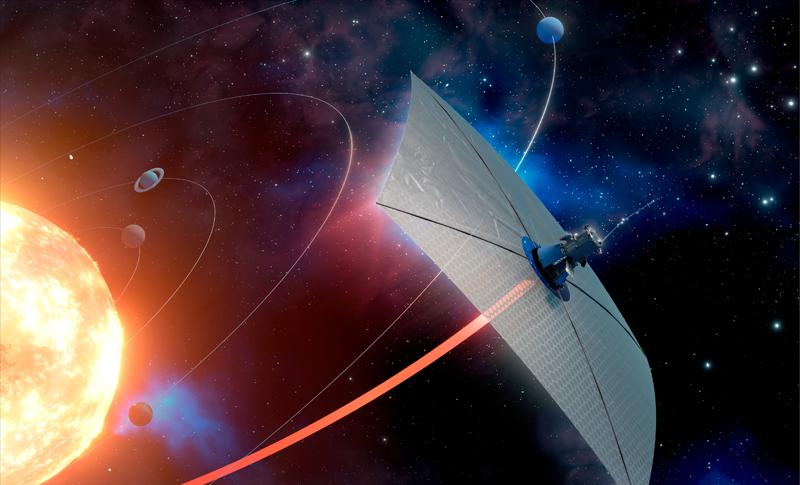
In the science fiction novel "Three-Body Problem", after the Trisolaran discovered that the Earth could survive, a large fleet of fleets quickly set out on the road, and will arrive in the solar system within 400 years, occupy the earth, drive all humans to Oceania, and occupy other lands and resources on the earth.
The reason why it takes 400 years is because the distance from Proxima Centauri to Earth is 4.2 light years, and the Trisolaran spacecraft can only reach 1% of the speed of light, which also causes The Earthlings to have 400 years to deal with it.
But now, the Trisolaran has not yet shot, a team of scientists in the United States is ready to preemptively "invade" the Trisolaran, and the time may only take 20 years!
The study, from the University of California, Santa Barbara, is the scientists' plan to consume one-tenth of the electricity of the U.S. power grid and accelerate the miniature light-sail spacecraft to 30 percent of the speed of light, so that it can reach Proxima Centauri within 20 years and start colonization of our solar system's nearest neighbor star system.
You may find it incredible, how big is the light sail spacecraft and can it carry people? In the book, hundreds of years after the development of earth science and technology, what can be sent to the trisolaran fleet is only a human brain.
The "colonizer" scientists envision is certainly not a human, but the toughest species on the planet, the tardigrade, which can live comfortably and comfortably, no matter what the extreme environment.
You may have lost your smile, isn't the tardigrade the prototype of the three-body man in "The Three-Body Problem"? When the environment was harsh, it dehydrated and hid in the warehouse, and Heng Jiyuan came to take it out and throw it into the water, and the soaking water was revived. American scientists are really naughty, is this to create a three-body civilization and turn science fiction into reality?
According to the theory of relativity, any object with a stationary mass, the faster it is, the closer it is to the speed of light, the greater the mass, the more energy is needed to accelerate, and in the end, no matter how much energy you consume, it is difficult to get one step closer to the speed of light.
So scientists are talking about using laser-accelerated lightweight light-sail spacecraft to "colonize" our nearest star system, which may be the only technology that is expected to be realized quickly.
According to scientists' calculations, large laser arrays could be built on Earth to concentrate on propelling light-sail spacecraft in space — perhaps the size of a human palm — accelerating it to 30 percent of the speed of light so that it could reach Proxima Centauri within 20 years.
Because the spacecraft is too small, of course, it is impossible to send humans over, and the small size, can withstand 151 ° C high temperature, close to absolute zero -272 ° C low temperature, up to 1000 times the lethal amount of human X-ray and other extreme radiation, or vacuum and extreme atmospheric pressure can survive the tardigrade, of course, is the best "human" choice.
However, the price to send tardigrades to the trisolaran is definitely not cheap, because the intensity of sunlight continues to decrease with distance, and a large laser array must be established on Earth to accelerate the light sail in space.
NASA's Starlight Program has developed a laser phased array that can be extended to the size required for relativistic flight, about 1 km to 10 km in size, and consumes 100 gigawatts of directional energy power per launch, about one-tenth of the U.S. power grid, which can gradually accelerate the light sail to 30% of the speed of light, so that it can reach Proxima Centauri within 20 years.
Are you rejoicing? Humans, no, human technology can finally get out of the solar system and colonize neighboring star systems. Although only insignificant tardigrades are colonized, in time, who dares to say that they will not evolve larger and more advanced species, or even intelligent life, on another planet?
But you may have forgotten one key – speed, so fast, 30% of the speed of light, how do you slow down when you reach Proxima Centauri? If they hadn't slowed down and crashed directly into the planet, the spacecraft would have vaporized directly, and the Tardigrade colonists would not have been able to withstand such extreme heat, and nothing could have survived.
Scientists have thought about various ways to slow down, but at 30% of the speed of light, none seem to be practical. At present, the most likely thing is to use the sunlight from Proxima Centauri to push backwards, but the calculations show that the speed of the light sail spacecraft needs to be less than 5% of the speed of light to be possible, so there is still no solution, even if the spacecraft is launched, it is useless, and the tardigrade colonists, I am afraid, can only change directly from the pioneer to the martyr.
I did think of a way, you can make the light sail into a mirror deformable, close to Proxima Centauri, let the light sail become a parabolic surface, the laser converges on the light sail, the reflection focuses on the mirror surface of the spaceship, and then the reflection reverse pushes the spacecraft, and at the same time, by adjusting the angle of the mirror, you can also control the flight direction of the spacecraft, which is similar to the reason why the sailboat sails against the wind.
Such a simple method, scientists have not thought of, the estimate is too difficult, there is no feasibility, what better way do you have?
The study was published in Acta Astronautica under the headline:
Interstellar space biology via Project Starlight